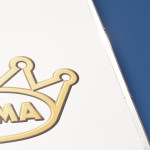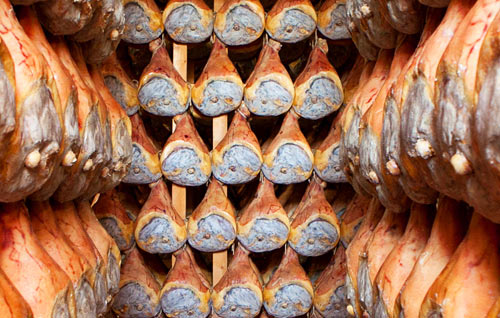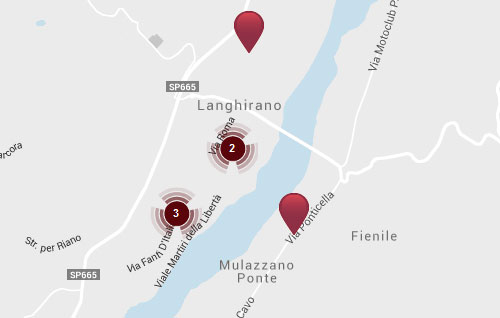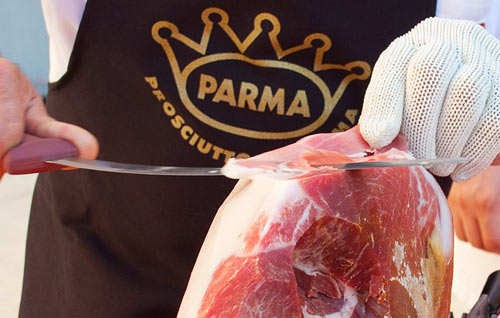The Parma Ham Festival is a unique occasion not only to visit the production sites, but also to discover how and where the is product born and admire and taste, peacefully, air and views of of Parma hills.
Cultural splendors you can visit
during the Festival
The “Devil's Ravine” - Calestano
The “Devil’s Ravine” is a spectacular sedimentary formation from the Cretaceous era (80-82 million years ago), a 5km long alignment of slender needles and narrow rocky walls (at Calestano head for Chiastre -10km, direction of Berceto); the visit is not guided.
Renato Brozzi Museum - Traversetolo
The Renato Brozzi Museum (Traversetolo, Via F. lli Cantini 8) offers an overview of the long working life of jeweller Renato Brozzi (1887-1963).
On show are chisels, statues, and cast works of various kinds by this local artist, who wished to donate his works to the municipality.
Magnani Rocca Foundation - Mamiano di Traversetolo
The Magnani Rocca Foundation, at Mamiano di Traversetolo, hosts the prestigious art collection of Luigi Magnani (1906-1984), that includes, amongst others, works by Gentile da Fabriano, Filippo Lippi, Carpaccio, Dürer, Titian, Rubens, Van Dyck, Goya and, from the modern school, Monet, Renoir, Cézanne, De Chirico, De Pisis, Burri, 50 works by Morandi, and sculptures by Canova and Bartolini.
From 12 September to 8 December, Exhibition of Giacomo Balla.
Tel. +39 0521 848327, info@magnanirocca.it
The Romanesque Parish Church of San Biagio in Talignano
The Romanesque Parish Church of San Biagio in Talignano, inside the Boschi di Carrega Regional Park, was built at the beginning of the twelfth century as a stopover for pilgrims travelling along the Via Francigena.
Tomato Museum - Giarola
The Tomato Museum and the Pasta Museum, the latter opened in May 2014 and entirely dedicated to the symbol of Italian food, are located within the medieval agricultural court of Giarola in Collecchio, an area historically dedicated to the production, processing and canning of food.
Website: www.museidelcibo.it
Felino Salami Museum
The Felino Salami Museum is situated in the restored cellar of the Castle and tells of the link between the tradition of processing the product and the territory.
Website: www.museidelcibo.it
Guatelli Museum - Ozzano Taro (Collecchio)
The Guatelli Museum in Ozzano Taro (Collecchio) is the fruit of the collection and display of 60,000 objects of daily use which Ettore Guatelli (1921-2000) dedicated a large part of his existence to, and which today, thanks to the Ettore Guatelli Museum Foundation, welcomes visitors from around the world – www.museoguatelli.it
Rocca Sanvitale - Sala Baganza
The Rocca S. Vitale in Sala Baganza was built in 1461 by request of Stefano Sanvitale and over the centuries has undergone numerous transformations which have changed its architectural and decorative structure. In 1612 the Farnese family confiscated the assets of the Sanvitale family, thus becoming masters of the fortress. During the 18th century, the structure was transformed, the Potager Garden was laid out, and some rooms were frescoed in the eighteenth-century style; the fortress was transformed into a hunting reserve, a fact that was to urge Maria Amalia of Hapsburg, the wife of Ferdinand of Bourbon, to settle here.
Historic Garden of the Rocca Sanvitale - Sala Baganza
The Historic Garden of the Rocca Sanvitale in Sala Baganza was reconstructed according to the original Italian-style design of the Farnese period. The restoration work returned to the Fortress its original garden, with more than 250 trees of holm oaks, apple blossom and quince trees following the geometries of the garden.
The Parish church of Collecchio
The Parish church of Collecchio, dedicated to St. Prospero, was mentioned for the first time in 1230 as a parish church controlling eight minor churches. The building’s original structure, which was later extended, is assumed to consist of a single nave with a T-shaped plan and three apses, and may date back to the end of the eleventh century, as a wall fragment dated 1089 seems to confirm.
Parish Church of San Pietro
Built on a hill in a very panoramic position and already documented in 1004, the Parish Church of San Pietro (Costa di Tizzano) was completed in the eleventh century. The main façade is a rare example of a “clocher-porche”, with a massive bell tower located at the first bay of the nave. Inside have been discovered a series of frescoes from the 15th century with biblical and courtly scenes.
Romanesque Parish Church of Moragnano
The Romanesque Parish Church of Moragnano, a small sandstone gem dedicated to Saint Juliana, lies on the Via Francigena which arrives from the sea to cross the Lagastrello Pass and reach the Po Valley Plain: on its walls, engraved into the stone, can be seen 2,000 drawings, symbols and phrases that pilgrims wanted to leave to posterity as a sign of their passage.
Neviano degli Arduini
Neviano offers a wonderful series of five museums. The extraordinary Historical Museum of Locks at Cedogno, a unique collection in the world, consisting of over 3000 locks of every historical era and from every country, which the owner Vittorio Cavalli proudly shows to all its visitors. The museum is known throughout the world and is a point of reference for the enthusiasts and scholars of ancient history.
To follow, the beautiful Man-Environment Museum at Bazzano that aims at reconstructing and promoting the importance of the landscape, in which the man lives and works, in a very interactive way. Not only the tools, but especially the “ingredients” of the land are collected in this small cultural centre, which helps us understand the profound relationship between man and the environment. An unusual and especially creative journey in a museum to “live”, which first of all wants to tell us something.
The Museum of the Italian Resistance at Sasso features all the memories of the partisan struggle for the liberation during the second world war, with a special focus on the events that occurred in the Apennines area of Parma between 30 June and 7 July 1944.
The Civic Collection of Contemporary Art, in the hamlet of Sella di Lodrignano, but also scattered in the surrounding area, in churches and homes, collects works of world famous contemporary artists, from the twentieth century to today. Painting, sculpture, photography, collage, prints and conceptual art are the pieces of history that the collection offers to its visitors.
The journey through these museums ends with the House-Museum of Bruno Bricoli, local artist that has interpreted the hilly landscapes of the eastern Apennines of Parma in naive style.
Created recently, for Expo 2015, the region features some fascinating trekking routes consisting of both dirt tracks and metalled roads that will reach all the panoramic landmarks of the Fuso valley, the traditional eateries, museums, villages and monuments, a one-off trip for an open-air holiday with a backpack: visit the Ring of Panoramas!
See more at: www.vallidelfuso.it or download Neviano App!
Parma Ham Museum
The Parma Ham Museum, located in the vast area of the former Cattle Market, offers a visit itinerary that allows you to follow the production process from pork to deli meats, the highly prized products of the butchers’ art from Parma.
Website: www.museidelcibo.it
Pallavicino Castle - Varano Melegari
Located 30 km from Parma, at the mouth of the Ceno valley, the Pallavicino Castle of Varano de’ Melegari, erected in 1208, is one of the more advanced examples of fifteenth-century military architecture, committed to adapting the old defensive schemes to new war needs.
Montechiarugolo Castle
The castle rises on the left bank of the Enza stream, on the border between the provinces of Parma and Reggio Emilia. The current structure, which according to legend is still haunted by the ghost of Fata Bema, was built on top of the remains of an old thirteenth-century nucleus destroyed in 1313, and presents the fifteenth-century layout given by Guido Torelli, a condottiero of the Viscontis and honoured with the feud of Montechiarugolo in 1406. Later, during the sixteenth century, when the castle was visited by illustrious guests such as Pope Paul III and the King of France Francis I, Pomponio Torelli, Humanist and scholar, it gained new splendour attracting artists and painters of the time.
Cellar of Food Museum
In the heart of an area dedicated to vineyards and wine, the charming cellars of the Rocca di Sala Baganza feature the “Cellar of the Food Museums”, an exhibition and sensory tour that is part of the itinerary of the Food Museums of the Province of Parma entirely dedicated to the wine in Parma, its history and its culture. The journey starts from the dawn of the archaeology of wine in the area of Parma, in collaboration with the National Archaeological Museum, and continues studying the aspects linked to the characteristics of the vine plant and viticulture going back to the origin of this cultivation in the Parma area.The museum ends with a look at Parma viticulture.
Castle of Torrechiara
The Castle of Torrechiara, built by Pier Maria Rossi between 1448 and 1460 overlooking the Val Parma, was designed from the beginning as an aristocratic dwelling for the count and his lover Bianca Pellegrini, as well as a defensive building. It is one of the most significant and well-preserved examples of Italian castles and combines medieval and renaissance elements. Its remarkable Gold Room is a hymn to love and its pains
Benedictine Abbey of Santa Maria della Neve
The Benedictine Abbey of Santa Maria della Neve was built in 1471 by count Pier Maria Rossi for his natural son Ugolino. The monastic complex, with its original fifteenth century lines, also includes an ancient Romanesque church and develops around a refined cloister of renaissance flavour. Visitors are welcomed by the monks who are still living there and by the unexpected artistic richness of the place. The abbey offers accommodation and has a valuable bee laboratory for the production and sale of cosmetic and herbal products.













